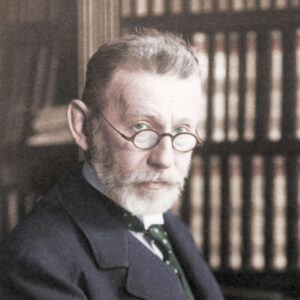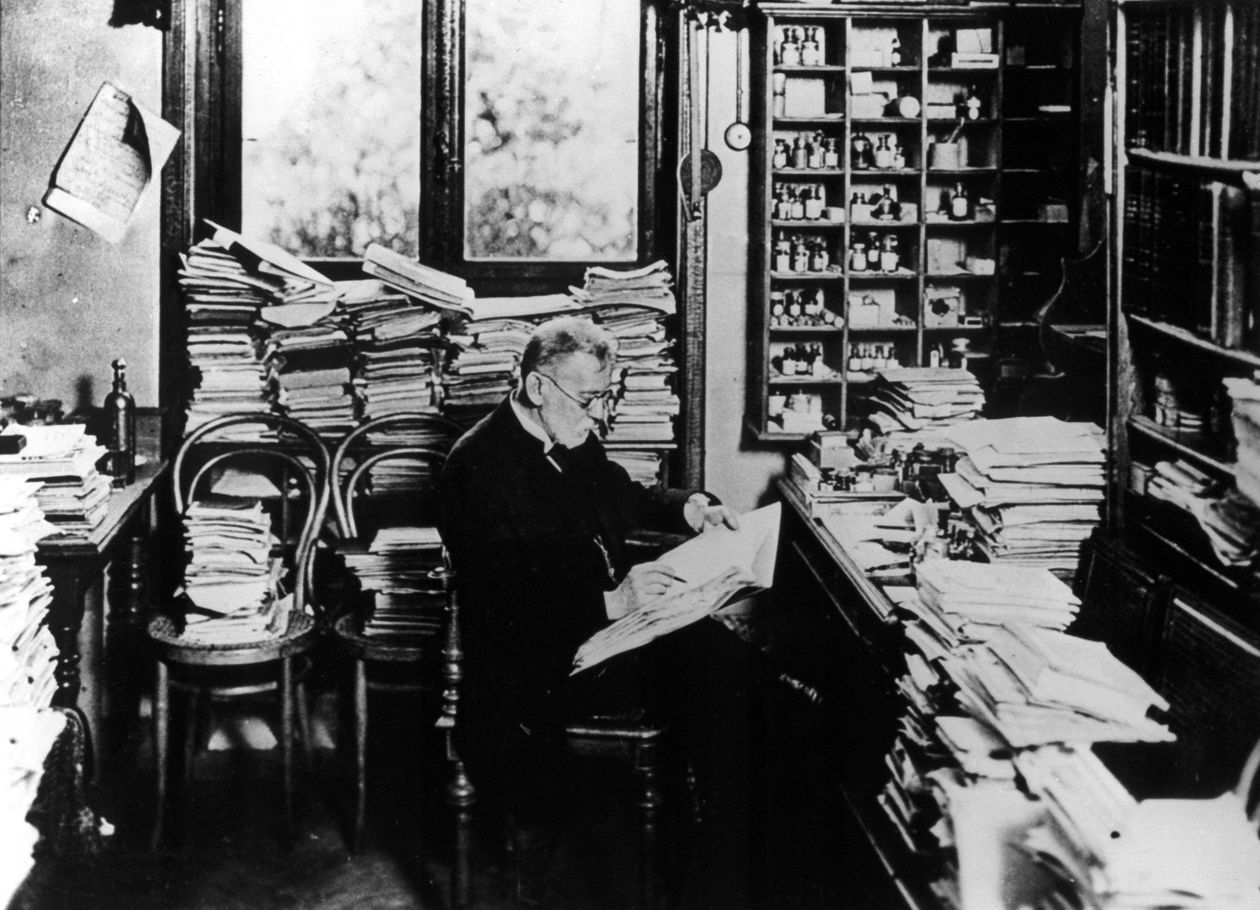‘Money, patience, skills and luck’
170 years ago, on 14 March, Paul Ehrlich, researcher, creator of modern drug design, Nobel Prize winner.
On 14 March 1854, Paul Ehrlich was born in Strzelin (Strehlen), then part of the Kingdom of Prussia. He belonged to a well-off Jewish family. His father, Ismar Ehrlich was an innkeeper and distiller of liqueurs and the royal lottery collector in Strzelin. He was also the leader of the local Jewish community. However, Paul showed little attachment to religious traditions. On his mother’s side, Rosa Weigert, he was related to Carl Weigert, an eminent pathologist who taught him staining techniques, and Fritz Weigert, who conducted research in chemistry and physics. Undoubtedly, the special atmosphere of the family home developed in young Paul respect for science and the need to acquire it. He also quickly began to show exceptional interest in natural sciences. Already while studying at St. Mary Magdalene Secondary School in Wrocław, he carried out his first attempts at microscopic examinations, fascinated by the techniques of staining preparations, which he discovered thanks to his acquaintance with Carl Weigert. He continued his education in medicine at the University of Wrocław, the University of Strasbourg, and the Albert Ludwig University of Freiburg. Finally, after moving with his supervisor Julius Cohenheim to Leipzig, he obtained a doctorate in medicine in 1878 with a thesis on staining (of course!) animal tissues with aniline compounds. Even today, obtaining a doctorate at the age of 24 is an amazing achievement, especially that Paul was not considered an outstanding student at all. Even more impressive was obtaining the title of professor just four years later. All thanks to his youthful passion for microscopic preparations staining. His work on staining tissues and cells has significantly contributed to the development of hematology. Among other things, he discovered basophilic mast cells and developed methods for distinguishing cells of the immune system. Thanks to this, he was also able to create the basis for the systematisation of anemia and leukemia. At the same time, he cooperated with Robert Koch, a microbiologist who discovered the tuberculosis pathogen. This period is of particular importance because it was when the belief began to grow in his mind that isolating and identifying the source of the disease would allow the development of tests that would help quickly find an effective drug.
It must be admitted that Ehrlich was very lucky. He was born into a wealthy family and grew up surrounded by outstanding representatives of his era. He liked to repeat that the key to success in science is 4xG, i.e.: „Geld, Geduld, Geschick und Glück” (money, patience, skills, and luck). Today, it is still difficult to find a better recipe for scientific success. However, Polish science has been maintaining surprisingly high standards, considering the ridiculous financing. This is possible thanks to the passion and skills of researchers, the patience of the community, and probably a lot of luck. Ehrlich’s words, however, require some comment, especially the issue of putting money first. This is not a sign of the pursuit of wealth or the materialism of a mannered descendant of local entrepreneurs. For some time, he even financed his research from his own funds and… his wife’s dowry. In 1883 he married Hedwig Pinkus, the daughter of a well-known Silesian textile mill owner. Paul Ehrlich moved for some time to Pródnik, his wife’s hometown, where his father-in-law’s position and his understanding of Paul’s scientific passion allowed Ehrlich to equip the laboratory and function even after losing his job. Thanks to this, he was able to discover that oxygen consumption depends on the type of tissue and can be related to the level of metabolism. What is more, he presented the possibilities of detecting this phenomenon using (of course) appropriate pigments. His monograph ‘The Need of the Organism for Oxygen’ was submitted as a habilitation thesis. At this point, our today’s hero was already known in the scientific community. Together with Robert Koch, he started research on the mechanisms of immunity development and the possibilities of using tuberculin in the treatment of tuberculosis. Although tuberculin was actively promoted as a revolutionary drug for treating tuberculosis, it ended in an atmosphere of scandal when the lack of the expected effect was revealed. That is why this part of Ehrlich’s biography is often omitted. Paul wanted to help his friend and employer so much that he injected himself with tuberculin to assure him of his support. However, when his work proved that tuberculin did not work, he found a new use for it – the substance is used to test for hypersensitivity in tuberculosis patients. He himself went to Egypt to improve his health, which was undermined by tuberculosis. Nevertheless, the failure of tuberculin certainly contributed to the development of his attitude towards the search for drugs, as they should work, but not harm.
Finally, in 1899, he moved to Frankfurt to become director of the Royal Prussian Institute for Experimental Therapy, established there to research cancer treatment options. First, Ehrlich moved there his research on immunity and serum for the treatment of infectious diseases such as diphtheria, which he had started in Berlin. In his inaugural lecture, he presented his side-chain theory, according to which immunity involves the production of chains by some cells that function as ‘traps’ for binding toxins in the body. Catching these structures when they are released into the blood allows them to be transferred to other organisms as a kind of antibody. This theory, considered by some a total madness, became the basis for awarding him the Nobel Prize in 1908 for research in the field of physiology and medicine.
His observation that fragments of biological structures can target pathogens very precisely, not harming other parts of the body, allowed him to hypothesise that the same can be expected from simpler chemical compounds that can be obtained in the laboratory. Such compounds should have the ability to recognise and bind the side chains of the pathogen – and only the pathogen. Drugs based on this hypothesis would become ‘magic bullets’ that would independently search for and destroy the disease-causing pathogen, bypassing healthy tissues and cells of the body. He also introduced the term ‘chemotherapy’ to emphasise that such drugs are created as a combination of chemical and biological knowledge. According to his favourite saying, Ehrlich just needed a little luck and a lot of money. Knowledge and patience were something he acquired during tedious work throughout his life.
A chemical molecule is a magic bullet that bypasses healthy cells and precisely destroys the threat (Robert Musioł, @biorender.com)
Fortunately, for him and the whole pharmacology, he met Franziska Speyer, the widow of George Speyer, a banker of Jewish origin. She decided to support the scientist’s efforts by funding the Georg Speyer Haus next to his institute and giving it to Ehrlich along with funds for research. In this way, a new, Georg Speyer Chemotherapeutic Research Institute was established – and it is still functioning today. In line with his growing belief that the search for new drugs should combine research in chemistry and biology, he set up such laboratories in the new building. The location of the institute in Frankfurt was exceptionally successful because the city had a dynamically developing chemical industry and gathered many great specialists. In the same year, Ehrlich published the article in which the term ‘chemotherapy’ appeared for the first time. It could have been found in the 4 September column of the ‘Frankfurter Zeitung und Handelsblatt’, entitled ‘Die Aufgaben der Chemotherapie’ (Challenges of Chemotherapy). He focused on parasitic diseases caused by trypanosomes. In humans, the most common, very widespread disease caused by trypanosomes was syphilis. This sexually transmitted infection caused by the bacterium Treponema pallidum, plagued in particular European societies. It is estimated that in the 19th century, every fifth young adult (between 15 and 34 years old) could require treatment against syphilis. However, this treatment usually consisted of rubbing mercury on the body, which was as harmful as the disease itself. There is even a saying ‘one night with Venus, a whole life with Mercury’ describing the unpleasant consequences of casual sex.
Paul Ehrlich began his search for an effective medicine by testing dyes. He quickly noticed that some of them, such as trypan red, were capable of destroying bacteria that caused disease in experimental animals. For some time he also tested arsanilic acid, which was also effective, but, contrary to its common name, ‘Atoxyl’, it showed significant toxicity. However, while testing other derivatives containing arsenic, he noticed that Compound 418 gave even better results. Finally, together with his assistant, Sahachiro Hata, they discovered arsphenamine, i.e. Compound 606 (the sixth in the sixth series – how can you still doubt in numerology?), which destroyed all bacteria after one dose. This compound, called Salvarsan (from a combination of the Latin words: salvare – to save, and sanus – health), was introduced for the treatment of syphilis in 1910, opening a new era of chemical antibacterial agents. However, it quickly turned out that Salvarsan was more harmful than originally expected and after two years it was replaced by Neosalvarsan. It is worth noting that despite the drug’s introduction into medical practice, its true structure was not known. This was presented in detail only in 2005. Moreover, Neosalvarsan was quickly replaced by even better antibiotics. However, the method developed by Ehrlich of searching for an active compound and modifying it to obtain more useful properties has become the gold standard in pharmacological research and is successfully used to this day. Paul Ehrlich and Sahachiro Hata tested about 300 compounds to obtain Salvarsan. Today, teams of scientists are testing tens and hundreds of thousands of compounds to create safer and more effective drugs. The period of great research at the Georg Speyer Haus and the growing fame of Paul Ehrlich coincides with events that cast a long shadow on European history. On 4 October 1915, he signed the infamous manifesto of support for Germany’s entry into the war. Less than a year later, he died of a myocardial infarction.
In 2009, a European network of universities educating doctors in the field of drug chemistry named after Paul Ehrlich was established (http://www.pehrlichmedchem.eu/). Currently, it unites 65 universities from 23 countries. Of course, the University of Silesia also belongs to it.
My favourite photo of Paul Ehrlich, taken in his office in the Georg-Speyer Haus in Frankfurt. It shows how often the seeds of scientific discoveries bloom in places where the untrained eye can only see chaos. © picture alliance/akg-images
Robert Musioł








